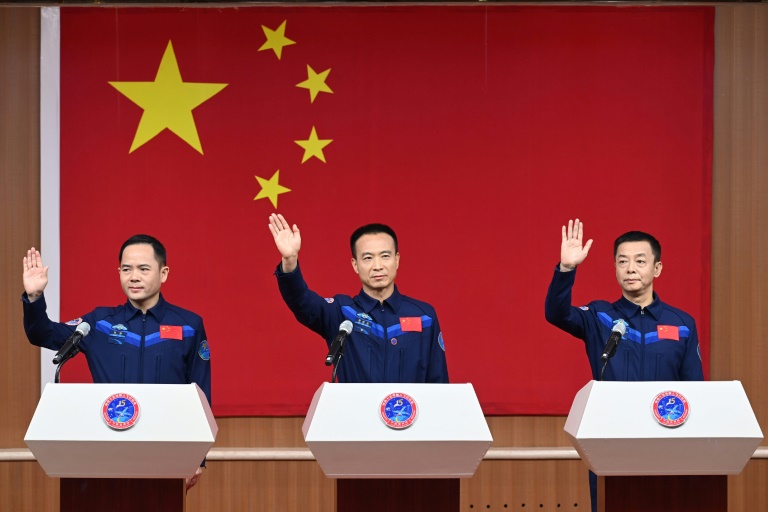Chinese astronauts Fei Junlong (C), Deng Qingming (R) and Zhang Lu (L), crew of the Shenzhou-15 spaceflight mission, wave at a press conference before the launch
China launched the Shenzhou-15 spacecraft on Tuesday carrying three astronauts to its space station, where they will complete the country’s first-ever crew handover in orbit, state news agency Xinhua reported.
The trio blasted off in a Long March-2F rocket at 11:08 pm (1508 GMT) from the Jiuquan launch centre in northwestern China’s Gobi desert, Xinhua said, citing the China Manned Space Administration (CMSA) said.
The team is led by veteran Fei Junlong and two first-time astronauts Deng Qingming and Zhang Lu, the agency said at a news conference on Monday.
Fei, 57, is returning to space after 17 years, having commanded the Shenzhou-6 mission in 2005.
His team will join three other astronauts aboard the Tiangong space station, who arrived in early June.
“The… main responsibilities for the mission are.. achieving the first crew-handover in orbit, installing… equipment and facilities inside and outside the space station and carrying out scientific experiments,” Ji Qiming, a spokesman for CMSA said.
“During the stay, the Shenzhou-15 crew will welcome the visiting Tianzhou-6 cargo ship and hand over (operations to) the Shenzhou-16 manned spaceship, and are planning to return to China’s Dongfeng landing site in May next year.”
The Tiangong space station is a crown jewel in Beijing’s ambitious space programme — which has landed robotic rovers on Mars and the Moon, and made the country the third to put humans in orbit — as it looks to catch up with major spacefaring powers the United States and Russia.
Tiangong’s final module successfully docked with the core structure earlier this month, state media said — a key step in its completion by year’s end.
“I expect that China will declare construction completion during or at end of the Shenzhou-15 mission,” independent Chinese space analyst Chen Lan said.
China has been excluded from the International Space Station since 2011, when the United States banned NASA from engaging with the country.
Once completed, the Tiangong space station is expected to have a mass of 90 tonnes — around a quarter of the ISS — or similar in size to the Soviet-built Mir station that orbited Earth from the 1980s until 2001.
Tiangong, which means “heavenly palace”, will operate for around a decade and host a variety of experiments in near-zero gravity.
Next year, Beijing plans to launch the Xuntian space telescope with a field of view 350 times that of NASA’s Hubble Space Telescope.









